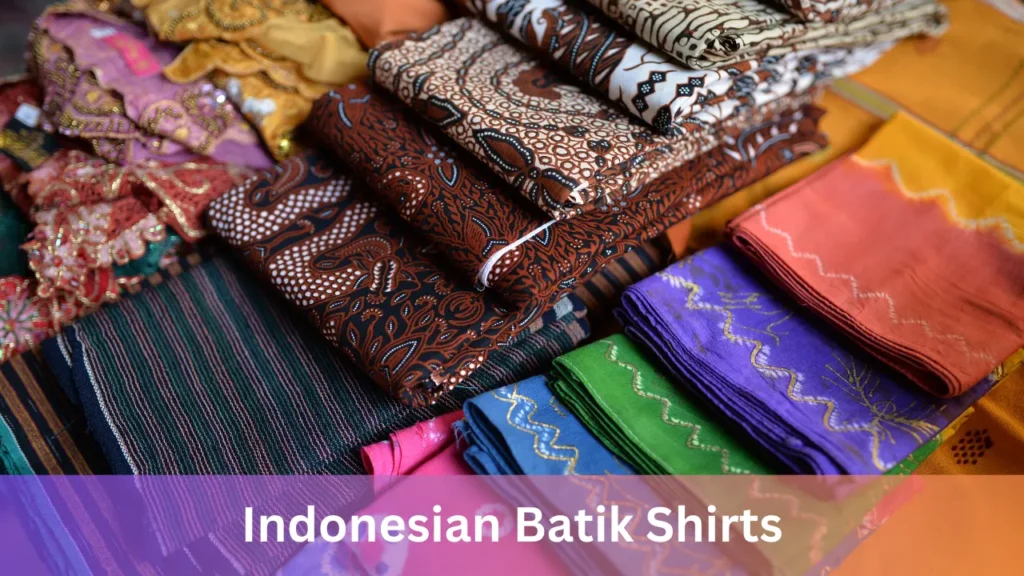Indonesian Batik shirts are traditional garments featuring intricate, wax-resist dyed designs. They reflect Indonesia’s rich cultural heritage and artistic expression.
Originating from the Indonesian islands, batik is not just a piece of fabric but a symbol of diversity and tradition. The delicate process of wax-resist dyeing and intricate patterning make each batik shirt unique. Known for their vibrant colors and elaborate motifs, these shirts capture the essence of Indonesian history and creativity.
Batik shirts are versatile, worn in formal settings or as casual wear, and are popular among both locals and tourists. UNESCO recognizes Indonesian batik as a Masterpiece of the Oral and Intangible Heritage of Humanity, which underscores its global cultural
significance. As a fashion statement, batik shirts stand out for their elegance and craftsmanship, making them a prized possession for those who appreciate traditional textiles.

Table of Contents
Toggle- The History Of Indonesian Batik Shirts
- Traditional Techniques Used In Batik Making
- Evolution Of Indonesian Batik Shirts
- Artisanal Craftsmanship Of Indonesian Batik Shirts
- Indonesian Batik Shirts In Modern Fashion
- How To Style Indonesian Batik Shirts
- Cultural Preservation Through Indonesian Batik Shirts
- The Economic Impact Of Indonesian Batik Shirts
- Frequently Asked Questions On Indonesian Batik Shirts
- Conclusion
The History Of Indonesian Batik Shirts
Batik shirts, originating from Indonesia, possess a rich and complex history that is deeply intertwined with the country’s cultural identity. The early origins of batik can be traced back to the Javanese royalty of the 17th century, where the craft was meticulously developed within the royal palaces of Yogyakarta and Surakarta.
The term ‘batik’ itself originates from the Javanese word ‘tik’ which means to dot. This traditional method of hand-dyeing fabrics by using a wax-resist technique has been passed down through generations. Artisans use a tool called a ‘canting’ or a stamp called a ‘cap’ to create intricate designs, symbolizing various cultural elements including mythology, nature, and spiritual beliefs.
The cultural significance of batik in Indonesia is immense as it is considered an intangible heritage by UNESCO, highlighting its importance as a symbol of national pride. Each region in Indonesia has its distinctive batik patterns, which reflect the local history and societal values. As a result, batik shirts are not just clothing items but a representation of Indonesian history and culture.
Traditional Techniques Used In Batik Making
Crafting Indonesian Batik shirts employs the wax resist method, a traditional practice where artisans meticulously apply hot wax to the fabric, creating a barrier against the dye. The areas covered in wax preserve the original color while the rest absorb the vibrant hues, revealing a pattern once the wax is removed. This technique ensures each piece is unique and detailed.
The Indigo dyeing process adds depth to the Batik shirts, involving a repeated cycle of dyeing and drying that enhances the intensity of the blue shades. It is a revered method for its high quality and the rich, colorfast nature of indigo, resulting in a prestigious and long-lasting garment.
The allure of Indonesian Batik is also in the intricate patterns and designs. These motifs are often symbolic and tied to the cultural heritage of the region, ranging from natural elements to abstract forms. Each pattern is laboriously hand-drawn or stamped, aspiring to tell a story and reflect the artisan’s skill.
Evolution Of Indonesian Batik Shirts
The influence of global fashion trends has significantly shaped the evolution of Indonesian Batik shirts. Designers globally have embraced Batik, incorporating its unique patterns and dyeing techniques into contemporary fashion. This cultural exchange has led to modern interpretations of Batik patterns, allowing traditional Indonesian motifs to flourish on the international stage.
The intricate designs characteristic of Batik have been reimagined to align with modern aesthetics, ensuring that Batik shirts remain relevant and coveted in today’s fashion world. Tailored cuts, vibrant color palettes, and the introduction of eco-friendly dyes
are just a few innovative approaches to enhancing the allure of these shirts. Through creative design, Indonesian Batik shirts continue to captivate both connoisseurs of heritage textiles and fashion-forward audiences alike.
Artisanal Craftsmanship Of Indonesian Batik Shirts
The craftsmanship of Indonesian Batik shirts is a testament to the meticulous skills of local artisans. These craftspeople have perfected the art of batik—a traditional dyeing technique involving wax-resist methods to create intricate patterns and vivid colors on fabric. Each shirt is not just a piece of clothing; it’s a canvas that showcases cultural narratives and ancestral motifs, painstakingly drawn and dyed by hand.
Sustainability practices are carefully integrated into batik production, reflecting a commitment to environmental stewardship and ethical manufacturing. Artisans often use natural dyes and source materials responsibly, ensuring that their creations have a minimal ecological footprint. By adhering to these sustainable methods, the batik industry supports the well-being of the planet and promotes the longevity of traditional techniques.
Indonesian Batik Shirts In Modern Fashion
Indonesian Batik Shirts have seen a surge in global appeal. The intricate designs and vibrant colors characteristic of Batik fabric have transcended borders, garnering attention on international runways and among fashion enthusiasts worldwide. With its unique patterns that blend traditional and contemporary art, Indonesian Batik has become a staple for those seeking cultural elegance in their wardrobe.
Renowned for their versatility, Batik shirts seamlessly incorporate into various styles, pairing well with both casual and formal attire. This fusion of tradition with modernity has led to significant collaborations with global designers, further securing Batik’s place in the international fashion scene. These partnerships have facilitated the creation of exclusive collections that honor Indonesian heritage while catering to contemporary tastes.
How To Style Indonesian Batik Shirts
Indonesian Batik shirts offer a unique blend of tradition and fashion, seamlessly adapting to various styles. Dressing them up with formal trousers and a blazer can transition an outfit from mere casual wear to business-appropriate attire. On casual days,
pairing Batik shirts with denim jeans can create a relaxed yet fashionable look. Accessorizing is key; a simple addition of a belt or a statement watch can define the overall outfit. Batik shirts also pair well with chinos, offering a smart-casual vibe perfect for weekend outings or casual Fridays at the office.
The vivid patterns of Batik shirts lend themselves well to layering, especially under solid-colored sweaters or cardigans. This allows the Batik to serve as a pop of pattern without overwhelming the ensemble. For ladies, tucking a Batik shirt into a high-waisted skirt
can be a bold fashion statement, encapsulating both elegance and cultural flair. With Batik’s versatile nature, it is a staple piece for anyone looking to introduce an exotic touch to their wardrobe.
Cultural Preservation Through Indonesian Batik Shirts
Indonesian Batik shirts are not merely garments but a proud emblem of cultural identity. Their intricate patterns and vibrant colors encapsulate centuries of artistic tradition. Batik holds such significance in Indonesia that it is considered a cultural heritage,
symbolizing the country’s history, ethnic diversity, and artistic ingenuity. The tradition of Batik, once a royal craft, has been passed down through generations, showcasing the rich cultural tapestry of Indonesia.
The UNESCO’s recognition of Batik as a Masterpiece of Oral and Intangible Heritage of Humanity in 2009 catapulted Indonesian Batik shirts into the global spotlight. This honor was a testament to the deep-rooted cultural significance and the exquisite
craftsmanship behind each piece. Subsequent preservation efforts have been crucial in keeping the Batik tradition alive, encouraging sustainable practices and supporting local artisans. These initiatives not only bolster the economy but also ensure that the legacy of Batik weaves into the future.
The Economic Impact Of Indonesian Batik Shirts
The economic significance of the Indonesian Batik industry cannot be understated, with its notable contribution to the country’s economy. Batik shirts, as a commodity, are more than just attire; they embody centuries-old cultural expressions and support the
livelihood of numerous local artisans. The preservation and promotion of this traditional craft spur economic activity and provide a source of income for many families within the communities responsible for their creation.
Indonesian Batik shirts play a crucial role in supporting local economies. By purchasing these garments, consumers are directly contributing to the economic empowerment of artisans. This support helps maintain the cultural heritage of Indonesia, as each
Batik shirt reflects the unique patterns and colors that tell a story of the nation’s rich history. The industry’s influence extends beyond direct employment by fostering related businesses such as textile suppliers, retailers, and the tourism sector.
Frequently Asked Questions On Indonesian Batik Shirts
What Is Indonesian Batik?
Indonesian Batik is a traditional textile originating from Indonesia. Characterized by intricate designs and patterns, it is created using a wax-resist dyeing technique. Batik is not only a cloth but is a cultural icon in Indonesia, often worn for special occasions.
How Is Batik Shirts Made?
Batik shirts are crafted through a meticulous process. Artisans apply wax to the fabric in specific patterns, and then dye it. The wax prevents dye from penetrating the cloth, creating unique designs once removed. This may be repeated to achieve multi-colored patterns.
Where To Buy Authentic Batik Shirts?
Authentic Batik shirts can be purchased in Indonesia, specifically in areas like Yogyakarta and Solo. For global shoppers, numerous online retailers and specialty stores offer genuine Batik garments. Ensure authenticity by checking for a reputable source and quality craftsmanship.
Can Batik Shirts Be Machine Washed?
Typically, Batik shirts require delicate handling. It’s recommended to hand wash them in cold water with a mild detergent. If machine washing is necessary, use a gentle cycle and avoid strong chemicals that can damage the fabric’s intricate patterns.
Conclusion
Indonesian Batik shirts aren’t just garments; they’re cultural emblems. Their intricate designs and vibrant colors offer a unique style statement. Embrace the tradition and diversity of Indonesia with these beautiful pieces. Explore the artistry, wear it with pride, and let every thread tell its story.
Discover batik and become part of a timeless fashion narrative.


